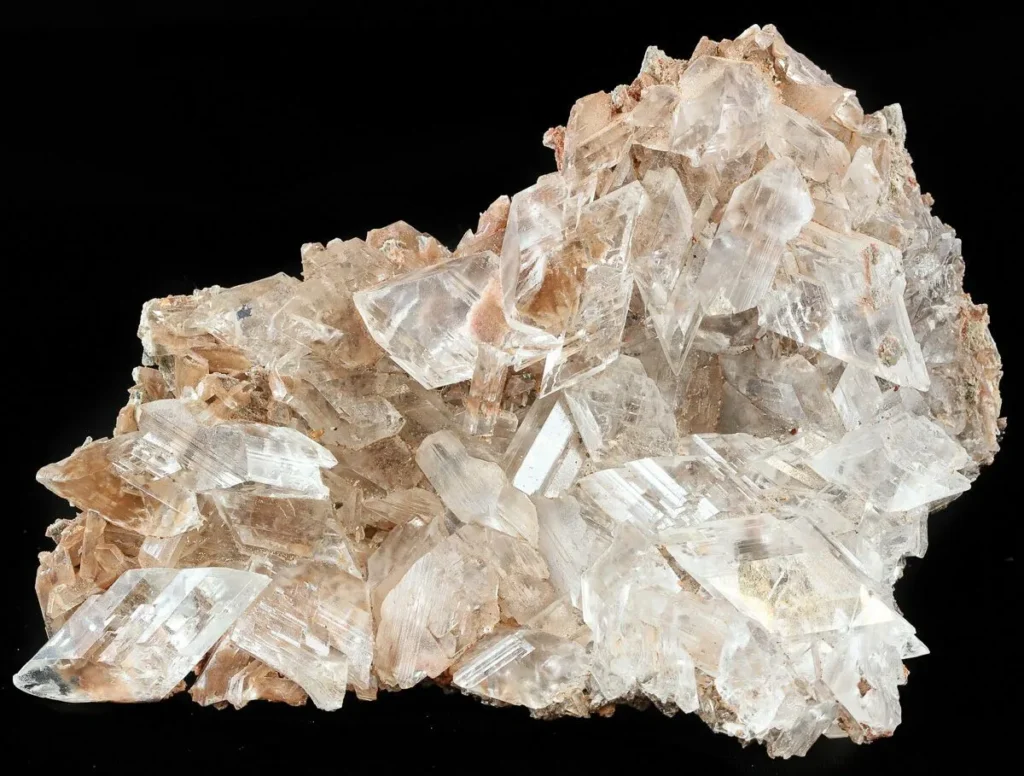
Appearance
Typically, selenite is white or colorless. It might also show mild brown, yellow, or orange tints because of imperfections in the crystal lattice. Because of its transparency or translucent nature, selenite’s crystal structure lets light through. Specimens that are thicker could seem more translucent than transparent. The luster of selenite crystals is either pearly or vitreous (like glass). When polished or illuminated, they can take on a stunning, radiant aspect. Crystals of selenite are frequently seen in tabular or prismatic forms. The crystals frequently form clusters or aggregates and might have an extended shape with a fibrous or columnar structure. It may also manifest as large, earthy, or granular forms.
Geographical Distribution
There are several places in the world where selenite can be found. It is mostly connected to evaporite deposits, which are created in arid or semi-arid regions when saline water evaporates. The following countries have significant selenite distributions and occurrences: Mexico, Morocco, the United States, Brazil, and Poland. Some other nations do contain selenite, however not as much. It can be found in nations including Canada, China, Australia, Germany, Italy, and Spain.
History
Although most people associate “selenite” with gypsum, the translucent version seen in crystals or crystalline masses has been called so since the fifteenth century. The term “moon stone” comes from Greek selēnítēs líthos, which is derived from Middle English selenite, which in turn comes from Latin selenites. It was once thought that the mineral waxed and waned in accordance with the Moon cycles, hence the name.
Chemical Composition
The chemical formula for selenite, a kind of gypsum, is CaSO4·2H2O. It is composed of calcium sulfate dihydrate, which implies that it has water molecules, sulfur, oxygen, and calcium in it.

Types
The following are some notable selenite forms and varieties:
Satin Spar:
A fibrous form of selenite known as “Satin Spar” is distinguished by its smooth, satin-like texture. It frequently has a silky sheen due to its fibrous texture, which is made up of parallel or radiating fibers. Satin Spar selenite is frequently used to create ornamental items like carved figurines or polished specimens.
Fishtail Selenite:
Angel Wing Selenite, another name for Fishtail Selenite, is distinguished by crystal forms that resemble fans or wings. The crystals frequently have an extended, flat appearance that resembles angel wings or the tail of a fish. A favorite crystal among crystal lovers, fishtail selenite is used in spiritual and energy work.
Window Pane Selenite:
Maria Glass, another name for Window Pane Selenite, is a translucent, colorless kind of selenite. Because of its great degree of transparency, light can flow through it practically like through a window. Window Pane Selenite is frequently employed in metaphysical activities like meditation and scrying.
Selenite Blades:
Selenite Blades are sharp-edged, thin, tabular crystals of selenite. They frequently create thin, translucent sheets or layers in groups or clusters. Due to their striking appearance, selenite blades are frequently utilized in energy healing or crystal grid systems.
Selenite Rosettes:
Intergrown selenite crystals form spherical or disc-shaped patterns known as selenite rosettes. They frequently have designs that are concentric or radial, like a rosette or flower. Collectors prize selenite rosettes for their striking symmetry and distinctive look.
Uses
- Decorative and Ornamental Purposes: Selenite is a popular decorative stone because of its pearly luster and translucent look. It is frequently carved into a variety of forms, including spheres, hearts, wands, and more figures. When lit, selenite lamps and candle holders have an ethereal radiance that makes them extremely valuable.
- Crystal Healing and Energy Work: Because of its therapeutic qualities, selenite is held in high respect within the metaphysical and spiritual communities. It is thought to have a cleansing and purifying impact on energy fields and auras. In order to encourage serenity, clarity, and a stronger spiritual bond, selenium is frequently utilized in energy healing sessions, meditation, and chakra balancing techniques.
- Jewelry: Jewelry made from selenite is occasionally utilized. Despite being a somewhat soft mineral, it can be worked into bracelets, earrings, and pendants. jewelry made of selenite is prized for its ethereal beauty and mystical qualities.
- Education and Research: In educational and research contexts, selenite is examined and utilized as a mineral. Examining selenite specimens helps geologists and mineral enthusiasts learn about crystallography, mineral production, and the geological processes related to evaporite deposits. Additionally, additional minerals linked to gypsum can be identified using selenite as a reference material.
- Industrial Applications: Selenite is a member of the gypsum mineral group, which has several uses in industry. In the building business, gypsum is frequently used to create plasterboard, plasterboard and other building materials. In order to enhance soil structure and nutrient availability, it is also utilized in agriculture as a soil conditioner and fertilizer additive.
Table





